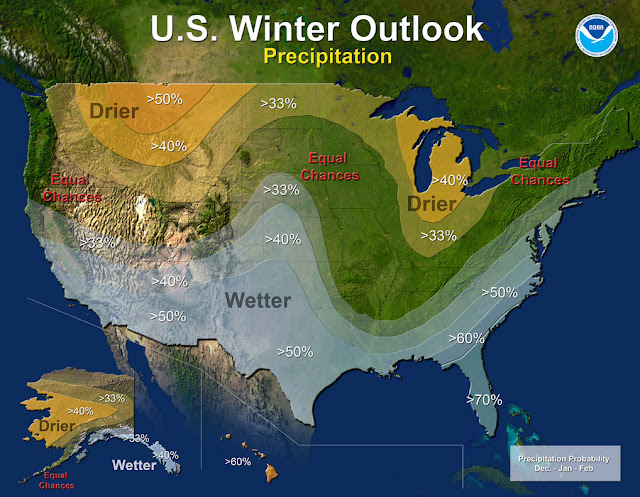|
LIMA, Peru — As 2015 drew to a close, South America saw almost unprecedented flooding. More than 100,000 people were evacuated from their homes in Paraguay, northern Argentina and southern Brazil as a result of unseasonal torrential rain. International media widely attributed the freaky weather to El Niño. Yet the whole truth is probably more complex.… Continue reading We can’t blame El Niño for all the world’s weather problems |
Tag Archives: el nino
New El Nino storm slams into Southern California
|
LOS ANGELES — Another El Nino-fueled storm soaked Southern California on Wednesday and brought with it flooding, mudflows and even a small tornado that struck Orange County in the early afternoon. Pea-sized hail and 45-mph winds made their way south from San Luis Obispo, forcing the region to recognize that the season of storms has commenced.… Continue reading New El Nino storm slams into Southern California |
NOAA Winter Outlook: Little clarity as to El Niño’s impact on Thornton

NOAA’s Climate Prediction Center released their 2015-2016 winter outlook this morning and while a strong El Niño will play a factor in some parts of the nation, its effects here are less clear.
As we have written about before, Colorado’s geographical location well inland, shelters it some from the effects of warm, Pacific waters. Overall snowfall in Colorado during El Niño years has not trended greatly one way or another. We have however seen some of our largest storms during El Niño.
NOAA’s outlook shows a pretty typical El Niño situation with some locations of the nation expected to receive copious amounts of moisture. For us, it does point to a bit better chance of a wetter than normal period from December to February.
Read the complete text of NOAA’s outlook below. At the bottom is the video they released to accompany it.

Forecasters at NOAA’s Climate Prediction Center issued the U.S. Winter Outlook today favoring cooler and wetter weather in Southern Tier states with above-average temperatures most likely in the West and across the Northern Tier. This year’s El Niño, among the strongest on record, is expected to influence weather and climate patterns this winter by impacting the position of the Pacific jet stream.
“A strong El Niño is in place and should exert a strong influence over our weather this winter,” said Mike Halpert, deputy director, NOAA’s Climate Prediction Center. “While temperature and precipitation impacts associated with El Niño are favored, El Niño is not the only player. Cold-air outbreaks and snow storms will likely occur at times this winter. However, the frequency, number and intensity of these events cannot be predicted on a seasonal timescale.”
Other factors that often play a role in the winter weather include the Arctic Oscillation, which influences the number of arctic air masses that penetrate into the South and nor’easters on the East Coast, and the Madden-Julian Oscillation, which can impact the number of heavy rain storms in the Pacific Northwest.
The 2015 U.S. Winter Outlook (December through February):
Precipitation Outlook:
- Wetter-than-average conditions most likely in the Southern Tier of the United States, from central and southern California, across Texas, to Florida, and up the East Coast to southern New England. Above-average precipitation is also favored in southeastern Alaska.
- Drier-than-average conditions most likely for Hawaii, central and western Alaska, parts of the Pacific Northwest and northern Rockies, and for areas near the Great Lakes and Ohio Valley.
Temperature Outlook:
- Above-average temperatures are favored across much of the West and the northern half of the contiguous United States. Temperatures are also favored to be above-average in Alaska and much of Hawaii. Below-average temperatures are most likely in the southern Plains and Southeast.
Drought Outlook:
- The U.S. Drought Outlook shows some improvement is likely in central and southern California by the end of January, but not drought removal. Additional statewide relief is possible during February and March. Drought removal is likely across large parts of the Southwest, while improvement or removal is also likely in the southern Plains. However, drought is likely to persist in the Pacific Northwest and northern Rockies, with drought development likely in Hawaii, parts of the northern Plains and in the northern Great Lakes region.
While it is good news that drought improvement is predicted for California, one season of above-average rain and snow is unlikely to remove four years of drought,” said Halpert. “California would need close to twice its normal rainfall to get out of drought and that’s unlikely.”
This seasonal outlook does not project where and when snowstorms may hit or provide total seasonal snowfall accumulations. Snow forecasts are dependent upon the strength and track of winter storms, which are generally not predictable more than a week in advance.
NOAA produces seasonal outlooks to help communities prepare for what’s likely to come in the next few months and minimize weather’s impacts on lives and livelihoods. Empowering people with actionable forecasts and winter weather tips is key to NOAA’s effort to build a Weather-Ready Nation.
NOAA’s mission is to understand and predict changes in the Earth’s environment, from the depths of the ocean to the surface of the sun, and to conserve and manage our coastal and marine resources. Join us on Facebook, Twitter, Instagram and our other social media channels.
El Niño Won’t Relieve West’s Drought, NOAA Predicts
|
Updated | Federal weather forecasters released their winter outlook Thursday, and it doesn’t look good for drought-stricken northern California, Oregon and Washington state. A strong El Niño this winter is predicted to intensify the Western drought through at least January, the National Oceanic and Atmospheric Administration announced. Earlier this week, NASA released a new image of… Continue reading El Niño Won’t Relieve West’s Drought, NOAA Predicts |
Study: Nature responsible for global warming, not man

A new peer-reviewed study calls into question the so-called ‘consensus’ on the causes of global warming by saying that “Nature, not man, responsible for recent global warming.” The new study authored by three Australian scientists and published in the Journal of Geophysical Research says that the El Niño-Southern Oscillation (ENSO) accounts for the vast majority of temperature variability.
Authored by Chris de Freitas (University of Auckland in New Zealand), John McLean (Melbourne) and Bob Carter (James Cook University), the new study is sure to cause waves among those debating the causes of global warming. Completely contrary to the mainstream media’s portrayal of climate change, the study says, “little or none of the late 20th century global warming and cooling can be attributed to human activity.”
Lead author de Freitas said in a press release, “The surge in global temperatures since 1977 can be attributed to a 1976 climate shift in the Pacific Ocean that made warming El Niño conditions more likely than they were over the previous 30 years and cooling La Niña conditions less likely.”
